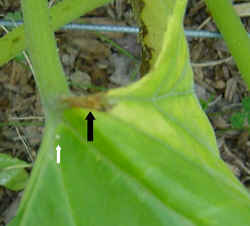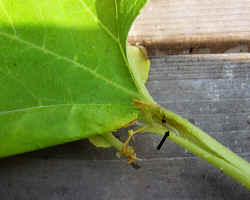|
Squash vine borers are a major pest in our garden. The adults are day-flying moths that look a little like a wasp. The larvae are the problem. They live in and dine on the stems of the squash plants. Some good websites describing the squash vine borer are: http://www.vegedge.umn.edu/vegpest/CUCS/vinebor.htm and http://attra.ncat.org/attra-pub/PDF/squash_pest.pdf. These sites also give some suggestions for control of the pest. The truth is nothing works really well. One needs a multi-level strategy. Or one can remove the dying vines and plant new squash under row covers. I am including this page because I have observed that the squash vine borer lays its eggs on the leaf near the junction with the leaf stalk. This location seems to be more prevalent than on the stem near the base of the plant. Most publications only mention the base of the stem. See the following pictures for evidence that the borers enter the squash plant at the leaf/leaf stalk junction.
 |
 |
| Black arrow indicates damage. White arrow indicates spot the same size as an egg. Eggs are dark red when first layed but become lighter. |
Young squash vine borer inside leaf stalk. Damage to leaf where it entered is evident. |
It makes sense when you think about it. If you are a tiny little worm, would you rather burrow into tender leaf tissue or a tough stem? Once inside the leaf stalk the borer has no trouble crawling down the inside of the hollow stalk to the stem of the plant. And it is protected the whole way!
Knowing this, one can find the eggs on the leaves, pick them off and put them in a small dish of soapy water. Once the borer is in the stalk, if you are lucky you can cut the leaf and get it out before it enters the stem. If there are many leaves with signs of borer damage, you can inject a solution of BT (bacillus thuringenisis) into the leaf stalks with damage. The solution will run down the hollow stalks to the stem where the borer is. I tried injecting directly into the stem. This doesn't work because the needle plugs up immediately. You can use a disposable plastic pipette to inject the stalks. Much easier and faster. Rinse the pipette and use it again. Use the powdered BT sold for caterpillar control. BT is a bacteria that kills caterpillars when eaten with the plant.
This approach will keep the squash plant alive and producing for several weeks. I am not saying it is a better approach than starting over with new plants. Just depends on how many squash are on the plant. If you have a squash plant die from borer damage, remove the plant as soon as possible and cut it open. Split the stem, remove and smash the borers before composting the plant.
|